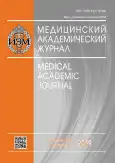STATE OF CYTOKINES, ALPHA-AMYLASE AS A MARKERS OF AUTONOMOUS NERVOUS SYSTEM AND CORRECTION WATER DRINKING BEHAVIOR
- Authors: Baisheva GM1, Melnik KN2
-
Affiliations:
- Samara state medical university
- Togliatti city clinical hospital
- Issue: Vol 19, No 1S (2019)
- Pages: 12-14
- Section: Articles
- Published: 15.12.2019
- URL: https://journals.eco-vector.com/MAJ/article/view/19296
- ID: 19296
Cite item
Abstract
The aim. Detect the relationship between sympathetic activity, secretory alpha-amylase (sAA) indices and mediators of the immune system in healthy young volunteers (18-20 years) with correction drinking behavior (use pure water of 35 ml/(kg body weight)). Materials and methods. A randomized, placebo-controlled double-blind study, which was carried out in 3 stages (09/20/2014; 08/11/2014; 12/13/2014) into 3 groups (test, placebo and control). The material used was saliva, in which IL-1β, IL-4, IL-6 were detected by ELISA and the activity of alpha-amylase (sAA) was determined colorimetrically on an automatic analyzer; the level of sympathicotonia was determined by calculating the Kerdo-index. Results. A decrease in the activity of sAA test and placebo groups to the second stage, and the preservation of this trend in these groups by the end of the study, in contrast to the increase in its activity in the control group. The ratio of IL-1β/IL-6 at the third stage (MCC, p = 0.048) in the test and placebo groups (146.66 and 111.61, respectively) exceeded (by 3 times and 2.4 times respectively) this indicator control group. In a subpopulation with a predictor of inflammatory diseases (PID) of the oral cavity (IL-1β ≥ 212 pg/ml) of the experimental group, the average IL-1β decreased to the third stage by 27% (from 247.7 pg/ml to 194.4 pg/ml), in the placebo group, a similar decrease was 31.5% (from 243.24 pg/ml to 184.96 pg/ml), while in the control the level of IL-1β remained at the same level (about 250 pg/ml), p > 0.05. By the end of the research, the Kerdo index showed a predominance in the test group of participants with parasympathicotonia (66.67%), while in the placebo group this figure was 58.33%, and in the control 50%. Conclusion. The obtained data suggest an immunomodulatory effect of the use of 35 ml/(kg body weight) of pure water (clean by the physical method) against a decrease in sympathicotonia.
Keywords
Full Text
About the authors
G M Baisheva
Samara state medical university
K N Melnik
Togliatti city clinical hospital
References
- Irwin MR, et al. Reciprocal regulation of neural and innate immune systems. Nature Reviews. Immuno¬logy. 2011;11(9):625-632.
- Kenney MJ, et al. Autonomic nervous system and immune system interactions. Compr Physiol. 2014;4(3):1177-1200.
- Rohleder N, et al. Determinants of salivary a-amylase in humans and metodological considerations. Psychoneuroendocrinology. 2009;34:469-485.
- Cozma S, et al. Salivary cortisol and α-amylase: subclinical indicators of stress for cardiometabolic risk. Braz J Med Biol Res. 2017;50(2):e5577.
- Melnik KN, Baisheva GM, Gilmiyarova FN, Alpatova TA. Salivadiagnosis as a method for determining immunological adaptation to learning stress in different drinking behavior. Clinical laboratory diagnostics. 2018;63(6):353-357.
- Panahov NA, Makhmudov TG. Assessment of parameters of local immune protection in patients with dental implants. Bulletin of the Kyrgyz-Russian Slavic University. 2017;17(10):82-86.
Supplementary files







